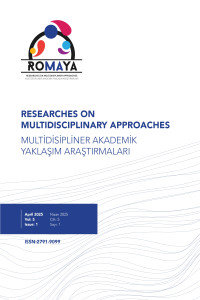A Comprehensive Analysis of Fractal Geometry in the Interior Architecture of the Astana Grand Mosque
Öz
In recent years, there has been a significant academic interest in the relationship between fractals and social networks. Both systems demonstrate complex self-organizing patterns, making them a subject of fascination. Fractals, characterized by self-repeating geometric shapes, and social networks, which depict intricate connections among individuals or entities, share structural dynamics that are worth exploring. This research aims to investigate these parallels, with a particular emphasis on the implications of fractal patterns in various disciplines like architecture
and sociology. A focal point of the study is the application of fractal geometry in the interior design of a mosque that was nominated for a prestigious Guinness award. The research examines how
fractals are utilized in this case, to create visually captivating designs and to symbolize deeper spiritual and social connections. By analysing this example, the research contributes to the broader understanding of the interdisciplinary nature of fractals and their potential impact across diverse fields such as physics, architecture, and social theory. Additionally, a fictional element is incorporated to further illustrate these concepts.
Anahtar Kelimeler
Fractal Geometry Social Network Islamic Architecture Interior Design
Kaynakça
- Abas, S. J., & Salman, A. S. (1995). Symmetries of Islamic geometrical patterns. World Scientific. https://doi.org/10.1142/2301.
- Abdelsalam, M., & Ibrahım, M. (2019). Fractal dimension of Islamic architecture: The case of the Mameluke Madrasas-Al-Sultan Hassan Madrasa. Gazi University Journal of Science, 32(1), 27-37.
- Abdullahi, Y., & Embi, M. R. B. (2013). Evolution of Islamic geometric patterns. Frontiers of Architectural Research, 2(2), 243-251. https://doi.org/10.1016/j.foar.2013.03.002.
Öz
Kaynakça
- Abas, S. J., & Salman, A. S. (1995). Symmetries of Islamic geometrical patterns. World Scientific. https://doi.org/10.1142/2301.
- Abdelsalam, M., & Ibrahım, M. (2019). Fractal dimension of Islamic architecture: The case of the Mameluke Madrasas-Al-Sultan Hassan Madrasa. Gazi University Journal of Science, 32(1), 27-37.
- Abdullahi, Y., & Embi, M. R. B. (2013). Evolution of Islamic geometric patterns. Frontiers of Architectural Research, 2(2), 243-251. https://doi.org/10.1016/j.foar.2013.03.002.
Ayrıntılar
| Birincil Dil | İngilizce |
|---|---|
| Konular | Arazi Kullanımı ve Çevre Planlaması |
| Bölüm | 2025 5/1 (April) |
| Yazarlar | |
| Yayımlanma Tarihi | 22 Nisan 2025 |
| Gönderilme Tarihi | 24 Kasım 2024 |
| Kabul Tarihi | 31 Aralık 2024 |
| Yayımlandığı Sayı | Yıl 2025 Cilt: 5 Sayı: 1 |


